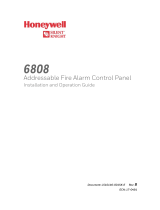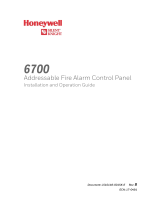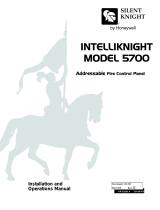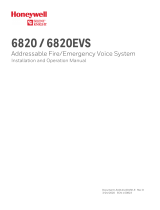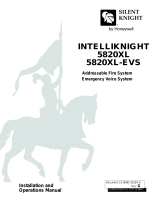Page is loading ...

1 I56-351-03
B401R Plug-in Detector Base
INSTALLATION AND MAINTENANCE INSTRUCTIONS
A Division of Pittway
System Sensor Europe
Via Caboto 19, 34143, Trieste, Italy
Before Installing
Please thoroughly read the System Sensor Manual I56-407,
Guide For Proper Use of System Smoke Detectors, which pro-
vides detailed information on detector spacing, placement,
zoning, wiring, and special applications. Copies of this
manual are available at no charge from System Sensor.
NOTICE: This manual should be left with the owner/user
of this equipment.
IMPORTANT: The detector used with this base must be
tested and maintained regularly following NFPA 72 require-
ments. The detector used with this base should be cleaned
at least once a year.
For use with the following smoke detectors: 1451E and 2451E
Specifications
Diameter: 10.2 cm (4.0 inches)
Height: 2.0 cm (0.8 inches)
Weight: 152 g (0.34 lb.)
Operating Temperature: –10° to +60°C (14° to 140°F)
Operating Humidity: 10% to 93% Relative Humidity
Electrical Ratings — includes base and detector
Voltage: 24 VDC
Maximum Ripple Voltage: 4 Volts peak to peak
Start-up Capacitance: 0.02
µ
F Maximum
Standby Ratings: 15 VDC Minimum
32 VDC Maximum
120
µ
A Maximum
Alarm Ratings: 10 mA Minimum at 10.5 VDC
62mA Maximum at 32 VDC
(If used, the RA400Z Remote Annunciator operates within the specified
detector alarm currents.)
Reset Voltage: 2.5 VDC Minimum
General Description
The B401R plug-in detector base is used with System Sen-
sor model 2451E photoelectronic detector head and model
1451E ionization detector head. The capability of plugging
these detectors into a variety of special bases makes them
more versatile than equivalent direct-wired models. Refer
to the System Sensor catalog for other plug-in detector
bases.
The B401R base is intended for use in 2-wire systems, with
screw terminals provided for power, ground, and remote
annunciator connections. The B401R base also contains a
resistor to provide current limiting in the alarm state.

2 I56-351-03
Base Terminals
NO. FUNCTION
1 REMOTE ANNUNCIATOR (+)
2 NEGATIVE (–) V IN, REMOTE ANNUNCIATOR (–)
3 NEGATIVE (–) V OUT
4 NOT USED
5 POSITIVE (+) V IN AND V OUT
NOTE: If remote annunciator is not used, polarity to these
terminals may be reversed.
Mounting
These detector bases mount to typical junction boxes. In-
stall the base to the box using the screws supplied with the
junction box. Figure 2 shows mechanical mounting details.
Wiring Installation Guidelines
All wiring must be installed in compliance with the Na-
tional Electrical Code and the local codes having jurisdic-
tion. Proper wire gauges should be used. The conductors
used to connect smoke detectors to control panels and ac-
cessory devices should be color-coded to prevent wiring
mistakes. Improper connections can prevent a system from
responding properly in the event of a fire.
For signal wiring, (the wiring between interconnected de-
tectors or from detectors to auxiliary devices), it is recom-
mended that single-conductor wire be no smaller than
1.5mm
2
, and that two- or three-conductor wire be no
smaller than 1.0mm
2
. For best system performance, alarm
loop conductors should be installed in separate grounded
conduit or shielded cable to protect the alarm loop from ex-
traneous electrical interference.
Smoke detectors and alarm system control panels have
specifications for allowable loop resistance. Consult the
control panel manufacturer’s specifications for the total
loop resistance allowed for the particular model control
panel being used before wiring the detector loops.
Wiring Instructions
Wire connections are made by stripping about 1 cm (3/8")
of insulation from the end of the wire (use strip gauge
molded in base), sliding the bare end of the wire under the
clamping plate, and tightening the clamping plate screw.
The zone wiring of the detector bases should be checked
before the detector heads are installed. To make this
possible, this base contains a special spring-type shorting
jumper (shown in Figure 2). After a detector base is
properly wired and mounted to an electrical box, make
sure that the shorting spring is in contact with terminal 3.
Figure 2. Mounting base to box:
A78-1468-01
SHORTING
SPRING
Figure 1. Terminal layout:
A78-1468-03
1
2
3
5
4

3 I56-351-03
This temporary connection permits the wiring of the loop
to be checked for continuity before installation of the
detector heads.
The shorting spring in the base will automatically
disengage when the detector head is removed from the
base. DO NOT remove the shorting spring, since it
reengages as the detector head is turned into the base,
completing the circuit.
Once all the detector bases have been wired and mounted,
and the loop wiring has been checked, the detector heads
may be installed in the bases.
Tamper-resistance Feature
This detector base also includes an optional tamper-resis-
tance feature that, when activated, prevents removal of the
detector without the use of a tool.
CAUTION
Do not loop wire under terminals. Break wire run to provide supervision of connections.
REMOTE
ANNUNCIATOR
2
1
3
5
4
+
–
2-WIRE CONTROL PANEL
+
–
REMOTE
ANNUNCIATOR
2
1
3
5
4
+
–
E
O
L
CLASS A OPTIONAL WIRING
NOTE: IF REMOTE ANNUNCIATOR
IS NOT USED, POLARITY TO
THESE TERMINALS MAY BE
REVERSED.
A78-1175-05
Figure 3. Typical wiring diagram for 2-wire detector system:
PLASTIC LEVER
BREAK TAB AT
DOTTED LINE BY
TWISTING TOWARD
CENTER OF BASE.
Figure 4. Activating tamper-resistance feature: Figure 5. Removing detector head from base:
A78-1468-02
USE SMALL-BLADED
SCREWDRIVER TO
PUSH PLASTIC LEVER
IN DIRECTION OF
ARROW.
To activate this feature, break off the tab on the detector
base (see Figure 4), then install the detector. To remove the
detector from the base after the tamper-resistance feature
has been activated, place a small standard screwdriver into
the small hole on the side of the base, and push the plastic
lever away from the detector head (see Figure 5). This will
allow the detector to be rotated counterclockwise for
removal.
The tamper-resistance feature may be defeated by breaking
and removing the plastic lever from the base, however this
prevents ever using the feature again.
Optional Remote Annunciator Units
The model RA400Z Remote Annunciator LED is available
as an optional accessory. This unit has a rectangular plate
that fits U.S. single-gang light switch boxes. If a different
type of remote annunciator is used, it must use less than
5ma at 3.0 V.

4 I56-351-03
© System Sensor 1996
Three-Year Limited Warranty
System Sensor warrants its enclosed smoke detector base to be free from
defects in materials and workmanship under normal use and service for a
period of three years from date of manufacture. System Sensor makes no
other express warranty for this smoke detector base. No agent, representa-
tive, dealer, or employee of the Company has the authority to increase or
alter the obligations or limitations of this Warranty. The Company’s obli-
gation of this Warranty shall be limited to the repair or replacement of any
part of the smoke detector base which is found to be defective in materials
or workmanship under normal use and service during the three year pe-
riod commencing with the date of manufacture. After phoning System
Sensor’s toll free number 800-SENSOR2 (736-7672) for a Return Authori-
zation number, send defective units postage prepaid to: System Sensor,
Repair Department, RA #__________, 3825 Ohio Avenue, St. Charles, IL
60174. Please include a note describing the malfunction and suspected
cause of failure. The Company shall not be obligated to repair or replace
units which are found to be defective because of damage, unreasonable
use, modifications, or alterations occurring after the date of manufacture.
In no case shall the Company be liable for any consequential or incidental
damages for breach of this or any other Warranty, expressed or implied
whatsoever, even if the loss or damage is caused by the Company’s negli-
gence or fault. Some states do not allow the exclusion or limitation of inci-
dental or consequential damages, so the above limitation or exclusion may
not apply to you. This Warranty gives you specific legal rights, and you
may also have other rights which vary from state to state.
The smoke detector used with this base is designed to activate and ini-
tiate emergency action, but will do so only when it is used in conjunction
with an authorized fire alarm system. This detector must be installed in
accordance with NFPA standard 72.
Smoke detectors will not work without power. AC or DC powered
smoke detectors will not work if the power supply is cut off.
Smoke detectors will not sense fires which start where smoke does not
reach the detectors. Smoldering fires typically do not generate a lot of
heat which is needed to drive the smoke up to the ceiling where the
smoke detector is usually located. For this reason, there may be large de-
lays in detecting a smoldering fire with either an ionization type detector
or a photoelectric type detector. Either one of them may alarm only after
flaming has initiated which will generate the heat needed to drive the
smoke to the ceiling.
Smoke from fires in chimneys, in walls, on roofs or on the other side of a
closed door(s) may not reach the smoke detector and alarm it. A detector
cannot detect a fire developing on another level of a building quickly or at
all. For these reasons, detectors shall be located on every level and in
every bedroom within a building.
Smoke detectors have sensing limitations, too. Ionization detectors and
photoelectric detectors are required to pass fire tests of the flaming and
smoldering type. This is to ensure that both can detect a wide range of
types of fires. Ionization detectors offer a broad range of fire sensing capa-
bility but they are somewhat better at detecting fast flaming fires than
slow smoldering fires. Photoelectric detectors sense smoldering fires better
than flaming fires which have little, if any, visible smoke. Because fires de-
velop in different ways and are often unpredictable in their growth, nei-
ther type of detector is always best, and a given detector may not always
provide early warning of a specific type of fire.
In general, detectors cannot be expected to provide warnings for fires re-
sulting from inadequate fire protection practices, violent explosions, es-
caping gases which ignite, improper storage of flammable liquids like
cleaning solvents which ignite, other similar safety hazards, arson, smok-
ing in bed, children playing with matches or lighters, etc. Smoke detectors
used in high air velocity conditions may have a delay in alarm due to dilu-
tion of smoke densities created by frequent and rapid air exchanges. Addi-
tionally, high air velocity environments may create increased dust
contamination, demanding more frequent maintenance.
Smoke detectors cannot last forever. Smoke detectors contain electronic
parts. Even though smoke detectors are made to last over 10 years, any
part can fail at any time. Therefore, smoke detectors shall be replaced after
being in service for 10 years. The smoke detector system that this detector
is used in must be tested regularly per NFPA 72. This smoke detector
should be cleaned regularly per NFPA 72 or at least once a year.
WARNING
The Limitations of Property Protection Smoke Detectors
/
